A riot that let to decades of martial law is remembered in a park in the heart of Taipei that contains museums, monuments, water features, statues and even a children’s playground and café. Today, it is a popular place to wander round and relax in a peaceful atmosphere but without forgetting the sacrifices that allow peace to rule in the country.

What to see at the 2/28 Peace Park in Taipei, Taiwan
The 2/28 Peace Park in Taipei contains two museums, water features and statues, in memory of the 228 Incident of 1947
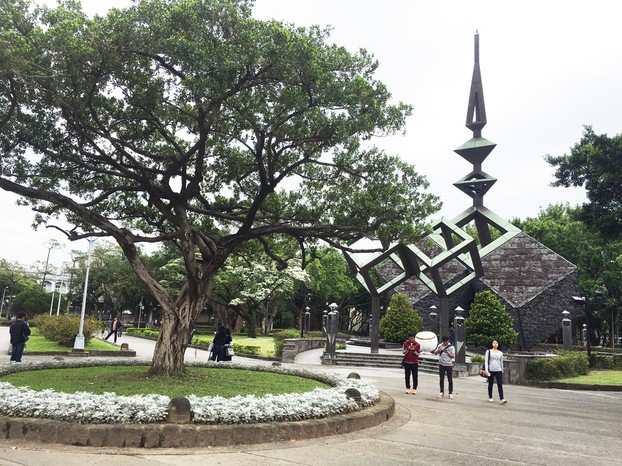 Monument in the centre of the 2/28 Peace Park in Taipei Photo by Steve Rogerson |
Those wandering the markets and streets in the area south of the Taipei Main Station will more likely than not come across a grassy area fronted by the Taiwan National Museum and known as the 2/28 Peace Park. The park itself was established in 1908 but has only been known as the 2/28 Peace Park since 1996 when it became a dedicated memorial to the 228 Incident of 1947.
The root causes of the incident date back two years earlier when Japan relinquished control of the island at the end of the Second World War, but the new Taiwanese national government was full of corruption and ruled badly as unemployment increased and prices rose steeply. The country was like a powder keg and it needed a single spark to set it off.
The spark was struck on 27 February 1947 when a 40-year-old woman was caught selling illegal cigarettes in the city and an officer hit her with the butt of his pistol. The reaction of locals watching the exchange was instant and a riot broke out and a civilian was shot dead. By the following day – 28 February after which the incident is named using the American system of writing dates – the riot had spread and there were anti-government protests across the country. Protesters even seized the local radio station, which is now the home of the 228 Memorial Museum in the park.
During the days that followed, many people were arrested and killed and, eventually, martial law was imposed and stayed in place for 40 years, until 1987, when it was relaxed and the country saw the beginnings of its modern day democracy.
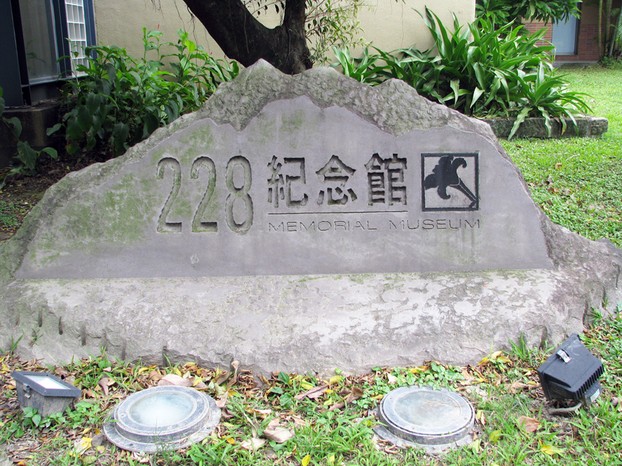 228 Memorial Museum Photo by Steve Rogerson |
228 Memorial Museum
In the south-east corner of the park, the Taipei Broadcasting Studio was built by the Japanese in 1930 and it stayed a radio station until 1973 when it became the home of the government’s Parks & Street Lights Office. In 1997, it was turned into a museum dedicated to telling the story of the 228 Incident.
Though nearly all the exhibits are labelled in Chinese, visitors can take advantage of free audio devices that explain the tour in Mandarin, Taiwanese, Hakka, Japanese or English. The 12 sections of the museum take visitors from the 1920s to help them understand the events in 1947, through the 228 Incident itself and the repression that followed to the modern peace movement for justice after martial law was abolished and ends in what is known as the International Human Rights Forest, a dedication to human rights movements around the world.
The museum is closed on Mondays and the day after national holidays. On other days, it is open from 10am to 5pm and the entry fee for adults is NT$20, and half that for children up to 12 years old, students, soldiers, police officers and some low-income groups. Some people are entitled to free admission including victims of the 228 Incident and their family members. There is a nice little café attached to the museum.
Taiwan National Museum
Established in 1908 and the oldest museum in Taiwan, the Taiwan National Museum tells the history of the island from its indigenous aboriginal population through to the modern day. It contains the normal museum fare of pottery, artefacts, woven cloth, jewellery, clothing and medical instruments. Although most have English and Chinese labelling, some exhibits only have the heading in English with the detailed information in Chinese.
There are special exhibitions within the building to the history of sound and vision on the island, the natural history of Taiwan, and the history of rice since wild rice was discovered in Taiwan 80 years ago.
The basement is used for temporary exhibits. Past exhibits, have included one dedicated to the history of diamond and charcoal and one featuring the work of those creating a digital archive of Taiwanese history. Much of the museum was closed during 2017 for refurbishment and, at the time of writing, was scheduled to reopen at the end of the year. However, the ticket also allowed entry during this period to the natural history museum opposite.
Like the 228 Memorial Museum, the national museum is closed on Mondays and the day after public holidays. Admission is NT$30 with a similar range of discounts to the other museum.
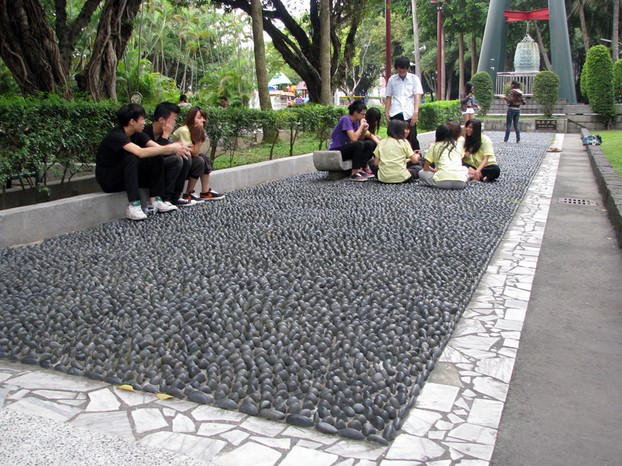 Stone footpath in the 2/28 Peace Park Photo by Steve Rogerson |
Also in the 2/28 Peace Park
The centre piece of the park is the Taipei 228 Monument, officially opened on 28 February 1995. The monument itself comprises several parts including a sphere through which passes the Tropic of Cancer. In the centre, underneath the tower, is a rectangular jade tube into which are engraved the names of the victims of the 228 Incident.
In the north-west corner of the park is a glass building housing two old locomotives. One is Locomotive No 9, the oldest locomotive used in Taiwan’s railways and built in England in 1871. It was used in Japan and moved to Taiwan in 1895. The other is Teng-Yung, the first steam locomotive used in Taiwan and built in Germany in 1887.
A stone footpath, painful to walk on bare footed, is said to bring health benefits to all parts of the body using reflexology principles. The park also contains a children’s playground, various water features and statues, and buildings and benches in and on which people can just sit and pass the time.
Getting there
The easiest way to get to the 2/28 Peace Park is by metro. One of the exits from the UTC Hospital station on the Red Line comes out in the park itself.
You might also like
Taipei, Taiwan: The Best Pubs and BarsSteve Rogerson looks at the growing craft beer scene in the Taiwan capital of...
Pubs and bars in Da Nang, VietnamA look at some of the pubs and bars in the growing tourist attraction of Da N...
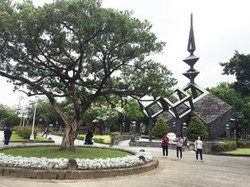





 KZine Issue 31: Review of October 2021 Issueon 11/07/2021
KZine Issue 31: Review of October 2021 Issueon 11/07/2021
 KZine Issue 30: Review of June 2021 Issueon 07/05/2021
KZine Issue 30: Review of June 2021 Issueon 07/05/2021
 KZine Issue 29: Review of February 2021 Issueon 02/23/2021
KZine Issue 29: Review of February 2021 Issueon 02/23/2021
 KZine Issue 28: Review of September 2020 Issueon 10/01/2020
KZine Issue 28: Review of September 2020 Issueon 10/01/2020

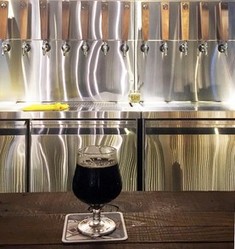
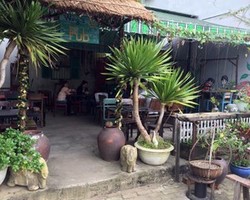
Comments
An interesting look at a fact most of us would not know.